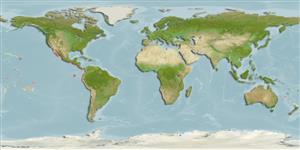>
Beloniformes (Needle fishes) >
Hemiramphidae (Halfbeaks)
Etymology: Hyporhamphus: Greek, hypo = under + Greek, rhamphos = beak, bill (Ref. 45335); naos: Named for the Naos Island, Bay of Panama, where the species is common and the site ot the Smithsonian Tropical Research Institute (STRI) Marine Laboratory..
Environment: milieu / climate zone / depth range / distribution range
Écologie
marin; saumâtre; profondeur 0 - ? m. Tropical
Eastern Pacific: from Baja California, with strays north to San Diego, CA, south to Paita, Peru and in the Galapagos Islands.
Taille / Poids / Âge
Maturity: Lm ? range ? - ? cm
Max length : 29.0 cm SL mâle / non sexé; (Ref. 96012); poids max. publié: 74.50 g (Ref. 96012)
Rayons mous dorsaux (Total): 12-16. This species is distinguished by the following characters: dorsal and anal fin bases of adults are covered with scales; first gill arch rakers total 29-39, second gill arch rakers total 21-28; pelvic to caudal extension falls anterior to opercle and posterior to upper jaw; for continental population, pelvic to caudal distance usually 0.44-0.47 to SL; preorbital length to orbital diameter usually greater than 0.70 (in 81% of 119 specimens examined) (Ref. 42105).
Inhabits inshore, coastal and estuarine; found along sand beaches, in lower tidal streams and mangroves. Usually encountered in schools at the surface of the water (ref. 42105).
Life cycle and mating behavior
Maturité | Reproduction | Frai | Œufs | Fécondité | Larves
Banford, H.M. and B.B. Collette, 2001. A new species of halfbeak, Hyporhamphus naos (Beloniformes: Hemiramphidae), from the tropical eastern Pacific. Rev. Biol. Trop. 49(1):39-49. (Ref. 42105)
Statut dans la liste rouge de l'IUCN (Ref. 130435)
Menace pour l'homme
Harmless
Utilisations par l'homme
Plus d'informations
PaysZones FAOÉcosystèmesOccurrencesIntroductionsStocksÉcologieRégime alimentaireÉléments du régime alimentaireConsommation alimentaireRation
Noms communsSynonymesMétabolismePrédateursÉcotoxicologieReproductionMaturitéFraiRassemblement de ponteFéconditéŒufsDéveloppement de l'œuf
RéférencesAquacultureProfil d'aquacultureSouchesGénétiqueElectrophoresesHéritabilitéPathologiesTraitementNutrientsMass conversion
CollaborateursImagesStamps, Coins Misc.SonsCiguateraVitesseType de nageSurface branchialeOtolithesCerveauxVision
Outils
Articles particuliers
Télécharger en XML
Sources Internet
Estimates based on models
Phylogenetic diversity index (Ref.
82804): PD
50 = 0.5000 [Uniqueness, from 0.5 = low to 2.0 = high].
Bayesian length-weight: a=0.00245 (0.00134 - 0.00449), b=3.11 (2.96 - 3.26), in cm total length, based on LWR estimates for this species & Genus-body shape (Ref.
93245).
Niveau trophique (Ref.
69278): 3.0 ±0.4 se; based on size and trophs of closest relatives
Résilience (Ref.
120179): Haut, temps minimum de doublement de population inférieur à 15 mois (Preliminary K or Fecundity.).
Fishing Vulnerability (Ref.
59153): Low to moderate vulnerability (25 of 100).
